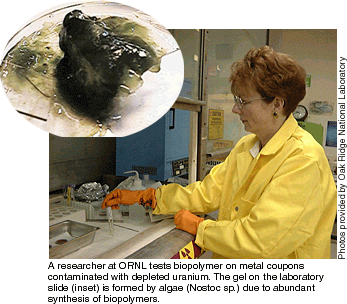
Through the Environmental Management Science Program (EMSP), DOE’s Office of Environmental Management (EM) and Office of Science (SC) collaborate to fund basic research to solve intractable problems that threaten the successful closure of DOE sites. As one of the programs within the Office of Science and Technology, EMSP ensures that OST’s projects cover the full spectrum of R&D. EMSP’s Web site is at http://emsp.em.doe.gov. The DOE cleanup program needs new and effective ways to decontaminate metal surfaces more economically. Current methods of stripping and power-washing metal surfaces contaminated with heavy metals and radionuclides are costly, partly because of the expenses of ensuring operator safety and disposing of large volumes of secondary waste. With funding from EMSP, researchers at Oak Ridge National Laboratory are developing an ingenious and deceptively simple solution to this problem. Principal investigators Brian Davison and Tanya Kuritz are developing "green" biopolymers into a system that is efficient, safe, and environmentally friendly. They propose to use aqueous biopolymer solutions to coat contaminated metal surfaces, solubilize the heavy metals on the surface, and bind the heavy metals into the environmentally benign biopolymer. The coating—including the immobilized contaminants—could then be removed as a viscous film or dry powder or by washing. The benefits of this "apply, wait, and remove" procedure are an increase in decontamination efficiency, with reductions in cost, secondary waste, and exposure hazards for workers. Algal and microbial biomass bind to a variety of heavy metals. In fact, biomass is already used for cleanup in wastewaters and groundwater, but not yet on surfaces. To develop an efficient and sustainable process for surface decontamination using biomass, Davison and Kuritz are building a fundamental understanding of important biological, chemical, and physical parameters of metal "chelation" (binding) by algal cells. The project encompasses selection and generation of cleaning agents, characterization of material properties, and study of transport properties.
A critical ancillary achievement of the project has been the development and validation of an accurate method to directly measure alpha radiation on the surface of the experimental samples, which was essential to quantify contaminant removal. The researchers found that different polymeric fractions have different sorption properties in regard to cadmium, iron, copper, and uranium. Metal sorption is the highest if polymer fractions are "charged" by different treatments. One of the polysaccharide fractions is the most efficient: it can bind 0.24 milligrams of uranyl per milligram of dry biomass and remove up to 90 percent of surface-bound U+6 as assessed by radioactive disintegration and inductively coupled plasma spectroscopy. This uranium stays immobilized in a peelable film. Tests continue on heavy-metal removal through sorption and adhesion from controlled, contaminated steel coupons and on physical "gel" properties for use as a coating. Davison and Kuritz hope eventually to perfect marketable biopolymers that could be spread or sprayed on contaminated surfaces in former process buildings undergoing decommissioning. The removed film—relatively small amounts of dry material containing concentrated, sorbed contaminants—could be disposed of as low-level waste. For further information on "‘Green’ Biopolymers for Improved Decontamination of Metals from Surfaces: Sorptive Characterization and Coating Properties," contact Brian Davison, (865) 576-8522, davisonbh@ornl.gov or Tanya Kuritz, (865) 241-6013, kuritzt@ornl.gov. |

 The research team isolated different biopolymer
fractions from several sheath-producing algal species (algal "slime") and tested
for polymer abundance, process cost, and rheological properties, eventually settling on Nostoc
muscorum, which grows easily on minerals in the presence of light. Cultures were
grown in a photobioreactor for five days, then left to mature (accumulate polymers) for a
month. Biomass was collected by filtration, dried, and then reconstituted in nitrate
buffer for metal-binding experiments. Copper was used to speed the first half of the
study, but critical experiments in the rest of the three-year project are using depleted
uranium.
The research team isolated different biopolymer
fractions from several sheath-producing algal species (algal "slime") and tested
for polymer abundance, process cost, and rheological properties, eventually settling on Nostoc
muscorum, which grows easily on minerals in the presence of light. Cultures were
grown in a photobioreactor for five days, then left to mature (accumulate polymers) for a
month. Biomass was collected by filtration, dried, and then reconstituted in nitrate
buffer for metal-binding experiments. Copper was used to speed the first half of the
study, but critical experiments in the rest of the three-year project are using depleted
uranium.